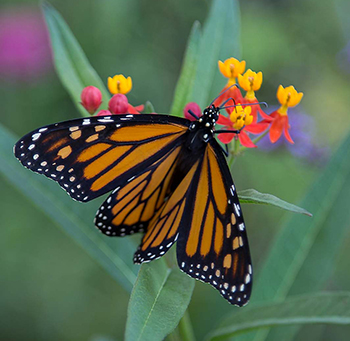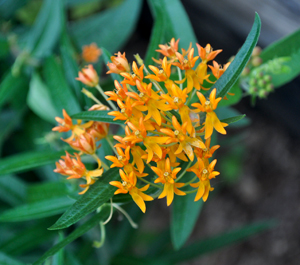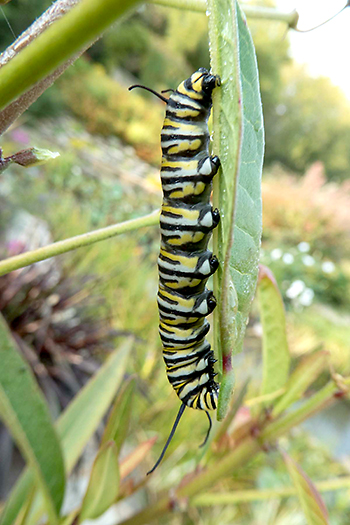Got Milkweed?
Return to Perennial Agent Articles
 “Got Milkweed” is a bumper sticker I see on the backs of many local cars. This theme is a reminder about the plight of the monarch butterfly. Much has been written lately about the decreasing numbers of monarchs caused by the loss of habitat and a complex range of issues. The latest call has been for everyone to plant more milkweeds from a local to national level.
“Got Milkweed” is a bumper sticker I see on the backs of many local cars. This theme is a reminder about the plight of the monarch butterfly. Much has been written lately about the decreasing numbers of monarchs caused by the loss of habitat and a complex range of issues. The latest call has been for everyone to plant more milkweeds from a local to national level.
Milkweed is the larval host plant of the monarch. That means that this family of plants is the food source for the larvae of the monarch. It is the only plant that the monarch larvae will feed on. Butterflies are host specific. Without milkweed the butterfly stage of the monarch has no place to lay its eggs. Monarchs will not lay eggs on any plant except milkweed. Simply put, no milkweed on which to lay eggs equals no larvae for the next generation of the species.
Planting more milkweeds is a great call for action. It sounds simple enough to do and a way for everyone to feel connected to the future of this species. As gardeners, who would not welcome a new plant to the garden? When it comes to milkweed we do have options. But as with any plant selection we must remember the old saying “right plant, right place”. Some milkweeds may have better manners in the garden, while others may become a little aggressive. Let’s take a look at our milkweed options for Kansas City gardens.
Butterfly Milkweed
 Asclepias tuberosa, or butterfly milkweed, is the most commonly planted member of this family in Kansas City gardens. Butterfly milkweed is a hardy, durable perennial, reaching about 2 feet in height while maintaining a nice rounded habit. The plant is prized for its early summer flowering. When in flower it is covered with bright orange blossoms that make a statement in the garden. This is a well-mannered plant. It forms a clump and does not spread. Some varieties of milkweeds do not stay put.
Asclepias tuberosa, or butterfly milkweed, is the most commonly planted member of this family in Kansas City gardens. Butterfly milkweed is a hardy, durable perennial, reaching about 2 feet in height while maintaining a nice rounded habit. The plant is prized for its early summer flowering. When in flower it is covered with bright orange blossoms that make a statement in the garden. This is a well-mannered plant. It forms a clump and does not spread. Some varieties of milkweeds do not stay put.
Butterfly milkweed is a Kansas and Missouri native plant. I enjoy this plant the most when traveling through the Flint Hills in the late spring and early summer as the roadsides and ditches are aglow with the fiery orange flowers. It grows best in well drained soils but will tolerate poor soil conditions. As a native it is extremely drought tolerant. In fact, wet soil conditions may be its only downfall. It prefers full sun. Some report that while this is the easiest to grow it may not be the favored host for monarchs.
Swamp Milkweed
Asclepias incarnate, or swamp milkweed, is a native perennial plant that can find its way into the garden. As the name implies this milkweed will tolerate and prefers to grow in moist, boggy soils. It can reach a height of 3 to 4 feet. Flowers appear in summer with pink tones. It is also a great choice for the home garden as it is a clumping milkweed. Like most milkweeds it has a tap root system and does not like to be transplanted.
Like all milkweeds it has a sticky white sap when broken and large seedpods that set after flowering. Swamp milkweed is a good source of nectar so adults of many butterfly species will visit this plant in the garden.
Green Antelopehorn Milkweed
Asclepias viridis, or green antelopehorn milkweed, is one of the lesser known plants in this family. It was a common perennial in our pastures and along the roadsides where I grew up in South Central Kansas. Green antelopehorn milkweed gets its name from the structure of the milkweed pod, which are long and horn-like. The seed pods are green until they dry and burst open with silky seeds which are dispersed by the wind.
This milkweed will reach a couple of feet tall and wide. It is a clump forming plant that does not spread, which is a good garden feature. It grows best in well drained soils and is considered very heat and drought tolerant. Compared to the other milkweeds it has an interesting flower structure that is hard to describe. The flowers are green with tinges of purple in a large umbel. While not as showy as butterfly milkweed, they still have a unique beauty of their own that attracts attention. I think it is the flower structure and color that drew me to this plant in its native habitat as a child in our pastures.
Common Milkweed
 Asclepias syriaca, or common milkweed, is a native perennial plant. Common milkweed should be planted with caution in a perennial garden as it does not behave in a garden setting. Unlike the other milkweeds this one spreads rapidly by rhizomes and seeds. It is a colony former and can take over a garden bed. The plant form isn’t the nicest either, having more of a weedy appearance.
Asclepias syriaca, or common milkweed, is a native perennial plant. Common milkweed should be planted with caution in a perennial garden as it does not behave in a garden setting. Unlike the other milkweeds this one spreads rapidly by rhizomes and seeds. It is a colony former and can take over a garden bed. The plant form isn’t the nicest either, having more of a weedy appearance.
Common milkweed will reach a height of 3 feet or more and produces white to light pink flowers during the summer. It is very heat and drought tolerant and does well in poor soil conditions. If planted in an enriched perennial garden soil I am afraid it would spread rapidly and overtake the garden. This milkweed is probably best suited for nature areas or planted in beds where its spread could be controlled. It is a favorite of the monarch.
Tropical Milkweed
Asclepias curassavica goes by either tropical or blood milkweed. Unlike the other plants mentioned, and as the name implies, this one is not native to the Kansas City area and is an annual. Tropical milkweed can be grown from seed or purchased in the spring as a transplant for the garden. It gets its name blood milkweed from the intense orange-red flower clusters on the plants.
Tropical milkweed will reach 3 feet or more in a summer. It grows best in the full sun but will tolerate very light shade. Keep in mind that butterflies are happiest when they can bask in the warm summer sun. They are also more likely to lay eggs in sunnier locations. Being an annual and not having an extensive root system, it will require even moisture for best growth but as an annual it is considered fairly drought and heat tolerant.
Balloon Milkweed
Asclepias physocarpa goes by several common names. Balloon milkweed is the more garden-friendly name but most people know this plant by the name hairy balls. It gets this intriguing name due to its interesting seed pod. Unlike the other milkweed this one forms a light green, rounded puffy pod with soft prickly-like structures. The entire pod is about the size of a ping pong ball. I will let you use your imagination from there.
This annual milkweed is big. I have seen it reach 5 feet or more in a garden, so if you plant it give it room to grow. The plant is not showy and does not have the best form. It is best planted in the back of the bed hidden by more attractive plants. It requires the same culture as the tropical milkweed.
No matter which of the species attract your attention, adding milkweed to the garden is a no-brainer. Many of them are beautiful plants that not only add beauty to the garden, but help the monarch on its life’s journey.
Additional Extension butterfly and pollinator resources can be found at http://www.johnson.k-state.edu/lawn-garden/extension-publications-and-videos/gardening-for-wildlife.html

Have questions? The Garden Hotline is staffed by trained EMG volunteers and Extension staff who will assist you with questions.
Phone: (913) 715-7050
Email: garden.help@jocogov.org